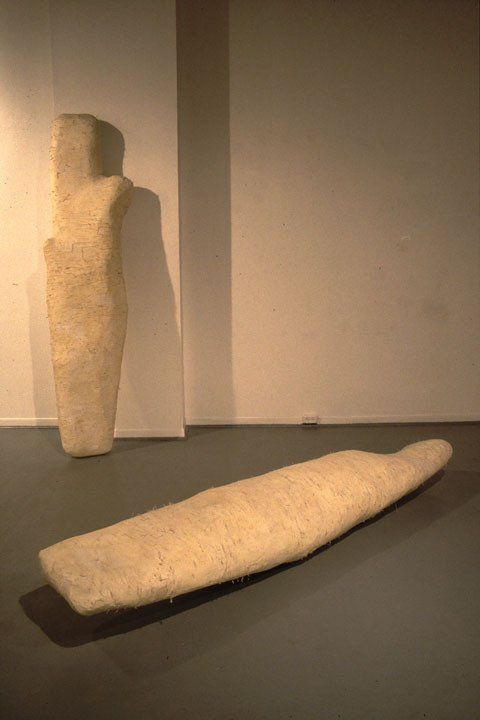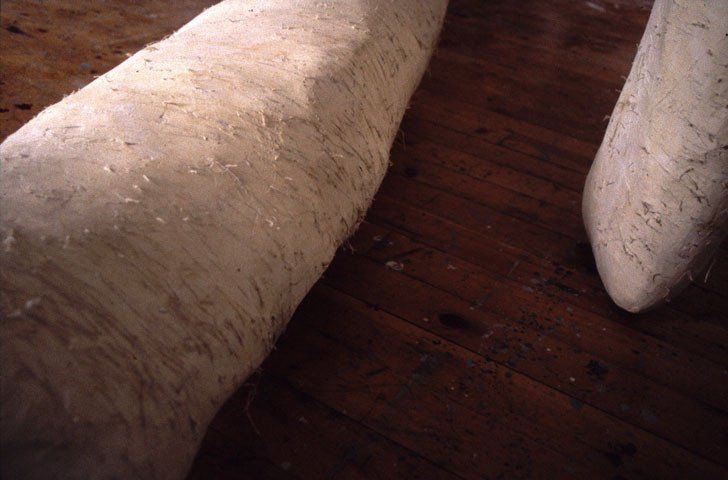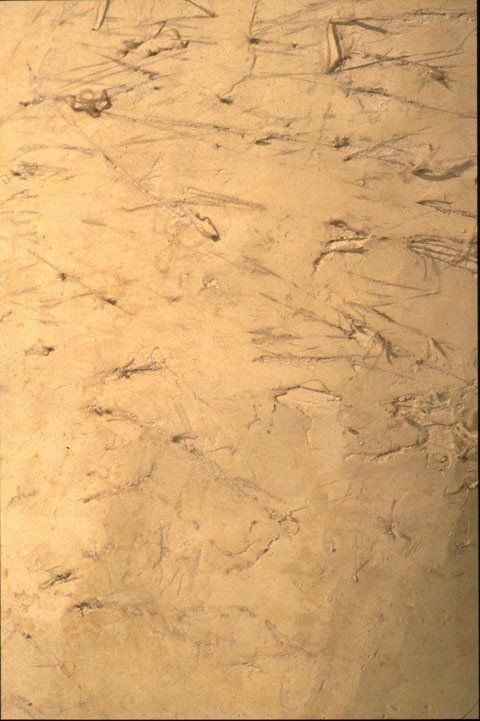Corporeal, 1998
Plaster (yellow hydrocal), linen yarn; two pieces: 23” x12” x 91” (60 x 30 x 230 cm); 18” x 14” x 96” (45 x 36 x 245 cm)
For a while I tried to manifest the theme "woods" that I explored with drawings in various more or less "spatial" ways. I was interested in the moment of spatial balance - finding a new surrounding of forms with every step that one takes while walking through the woods. As well I was interested in the personal encounter that could be manifested by a work of art in a gallery that was translated directly from such an experience.
For a while I had tree-trunk-like shapes "growing" in the studios that I worked in - or hauled branches or fabricated poles inside, waiting for the idea to come. Today I think that, really, by letting this idea go, I probably found it in the piece that I call now "Corporeal". It is far less spectacular than I wanted my woods-piece to be and at the same time it is more substantial than the thought that I had before and worked around, which implied too direct references.
"Corporeal" consists of two forms that are worked in plaster, a yellowish hydrocal. The surface of the pieces appears layered and woven. It reveals fibers that merge with the almost skin-like or wood-like plaster surface. The shapes are things in themselves (about 240cm long/high and between 30 and 60cm in diameter) that allow for various associations. Like driftwood rather than wood, they allude to some natural material that has taken a form which vaguely reference the proportions of the human body. One element rests on the floor, the other leans against a pillar. A comment that I wrote in connection to a group show that I participated in is as follows: The smooth surface of the two forms is wrapped, worked and incised with fine linen yarn, thus layering up and tracing the nature of form of the objects. They are moveable, either resting on the floor or leaning against the wall, a post. The objects seem to be familiar, corporeal in their appearance, but in the same moment they obscure one's perception by obviously manifesting something strange and unknown. They enforce a questioning, investigating, change the atmosphere of an existing space by opposing the human body with sculptural objects of a similar and confrontational scale.
Gips (yellow hydrocal), Leinengarn; Zwei Teile: 60 cm x 30 cm x 230 cm; 45 cm x 36 cm x 245 cm
Für eine Weile versuchte ich das Thema Wald, das ich in meinen Raumzeichnungen in mehr oder weniger räumlicher Weise untersuchte, zu manifestieren. Ich interessierte mich für den Moment eines räumlichen Gleichgewichts, ein neues Umfeld zu finden, mit jedem Schritt, den man bei einem Spaziergang durch den Wald macht. Außerdem interessierte ich mich für die persönliche Begegnung die durch ein Kunstwerk in einer Galerie manifestiert werden könnte, das sich von einer solchen Erfahrung in der Natur direkt übersetzen lässt.
Eine zeitlang wuchsen baumähnliche Formen in den Ateliers, in denen ich arbeitete oder ich schleppte Zweige und Äste und vorgefertigte Holzpfähle herein, immer auf eine zündende Idee hoffend. Heute denke ich, dass ich dadurch, dass ich diese Idee endlich losgelassen habe, genau diese Idee in der Arbeit "corporeal" (körperlich) wiedergefunden habe. Sie ist wesentlich weniger spektakulär als meine "Waldarbeit" sein sollte und gleichzeitig viel wesentlicher als der vorhergehende Gedanke, der viel zu direkt im Ansatz war.
"Corporeal" besteht aus zwei Formen, die in gelblichem Gips gearbeitet sind. Die Oberfläche der Elemente ist geschichtet und verwebt. Sie enthüllt die Fasern, die mit der fast hautähnlichen oder holzähnlichen Oberfläche verschmelzen. Die zwei Formen sind "Dinge", selbstständige Objekte, die eine Vielzahl von Assoziationen erlauben. Wie Treibholz assoziieren sie natürliches Material, das eine Form angenommen hat, die vage an die Proportionen des menschlichen Körpers erinnert. Eine Form liegt auf dem Boden, die andere lehnt gegen eine Säule oder eine Wand.
In Verbindung mit einer Gruppenausstellung, in der die Arbeit war, schrieb ich folgenden Kommentar: Die weiche Oberfläche der zwei Formen ist gebunden, bearbeitet und eingeritzt, eingeschnitten mit feinem Garn aus Leinen, das sich aufschichtet und die Spuren der ursprünglichen Form der Skulptur nachzeichnet. Sie sind nicht statisch, entweder ruhen sie auf dem Boden oder lehnen gegen die Wand, eine Säule. Die Objekte scheinen vertraut, körperlich in ihrer Erscheinung, aber im selben Moment verunklären sie unsere Wahrnehmung, denn ganz offensichtlich manifestieren sie etwas Fremdes und Unbekanntes. Sie bestärken ein in Frage stellen, ein Untersuchen, verändern die Atmosphäre eines vorhandenen Raumes, indem sie dem menschlichen Körper Skulpturen, gemachte Formen entgegenstellen, die von einer entsprechenden und sich gleichzeitig widersetzenden Größe sind.




